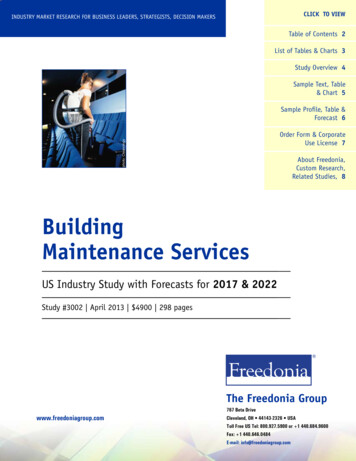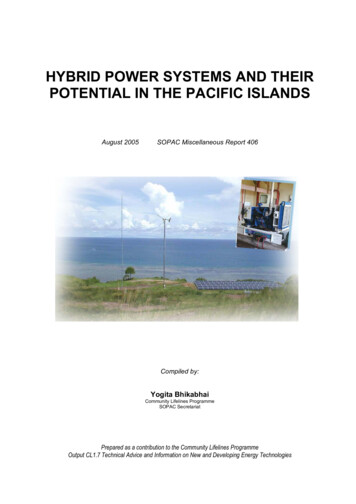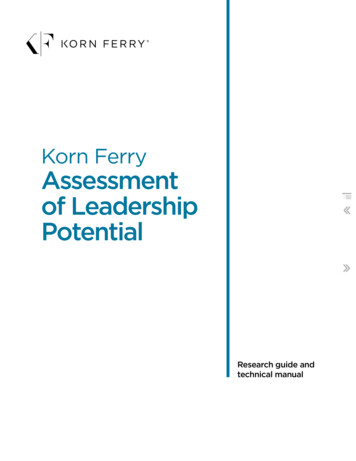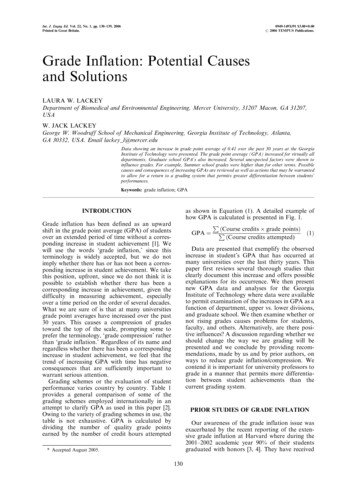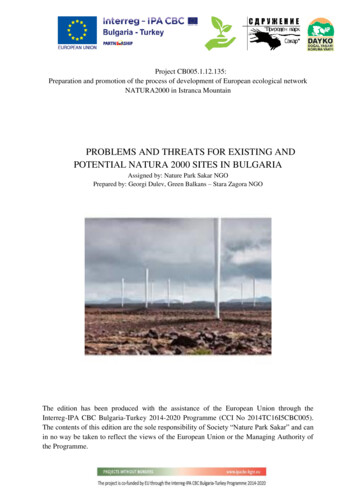
Transcription
The Business Development FilesEstimating Market Potential:Is There a Market?Estimating Market Potential:Is There a Market?Karen Mundy, Department of Agricultural and Applied Economics, Virginia TechS. Gary Bullen, Department of Agricultural and Resource Economics, N.C. State UniversityAdapted from material by Kent Wolfe, Department of Agricultural and Applied Economics,University of GeorgiaPart 1. What the Agent Needs to KnowYour clients have decided the price they want, thegeographic location of the market, their possiblecustomers, and who and where the competition is. Next,they must calculate the portion of the market they canreasonably expect to capture. Market potential is anestimate of the amount of money your clients can expectto make from the product or service they plan to market.Their estimate will only be as good as the informationthey use and the assumptions they make. There are sevensteps to estimating market potential (they have alreadycompleted the first four steps).1.2.3.4.5.6.7.The market potential is the number of potential buyers, anaverage selling price and an estimate of usage for a specificperiod of time. The general formula for this estimation issimple:Estimating Market PotentialMP N MS P QWhere:MP market potentialN total number of potential consumersMS market share—percent of consumersbuying from youP average selling priceQ average annual consumptionDefine the market segment (target market).Define the geographic boundaries of the market.Define the competition.Define the market size.Estimate market share.Determine the average annual consumption.Estimate an average selling price.Step 5, estimating the market share or potential, will allowyour clients to determine if their markets will support theirbusinesses by covering their costs and paying them a salary.Generally, the market potential is the highest estimated netrevenue that they will realize from their enterprise. In thesecond meeting, you covered estimating a price. When theyestimate market potential and use the price they calculated,they will see if they have covered their costs. One way foryour clients to use their market potential analysis is tochange their assumptions and see if they can still covertheir costs. They can either lower their expectations of thenumber of people who will buy from them, or they canraise their prices. Writing down the assumptions they useto estimate their market potential and the changes theymake to those assumptions is essential.To illustrate the concepts discussed, we use the agritourismexample of a farmer wanting to add a corn maze andeducational tour.Define the market segmentYour clients have identified the target market of thecustomers who are most likely to buy from them. Thetarget market was generally described using demographicvariables: gender, age, education and income. The marketis also described using psychographic variables: lifestyle,interests and belief system variables. A client might havemore than one target market. The most important pieceof information from identifying the market is how manypotential customers fit the target market description basedon the variables a client chooses:30
Estimating Market Potential: Is There a Market? agemarital statushousehold incomegenderrace/ethnicityeducationThe Business Development FilesDefine the market sizeOnce a client has defined the market area, target marketand total number of people in that market, he calculatesthe number of potential customers for the business.The total market will typically be adjusted downward toconsider those who will not buy from your client. From thetotal people in the target market, the client estimates thepercentage of consumers who would use the products orservices.Because not everyone in the defined market area will be acustomer, each client needs to compare the target marketprofile to the population in the market area (see Bullen,2006). Market areas are defined in several ways. Somemethods require easy-to-collect data, whereas othersrequire more complex data and the services of a marketingprofessional.Example—AgritourismAssume the farm is already an agritourism operation.Your client wants to offer a corn maze as well assomething educational. The client decides to targetchildren in kindergarten through third grade. The targetmarket area is Wake County, which has 45,700 childrenbetween 5 and 9 years of age. Therefore, N (number ofpotential customers) 45,700. They found this numberin the 2000 U.S. Census.Define the geographic boundaries of their marketYour clients have defined their market areas by geography,ring analysis or radius, trade area or drive-time. Mostlikely, they used geography, the simplest form of defining amarket area. It defines the market area by using landmarksor some jurisdictional boundary, such asDefine their competitionHowever, not all children under 9 will visit anyagricultural facility. The client’s next step is to adjustthe 45,700 to get a more accurate estimate of theactual market potential. A survey of elementary schoolteachers showed that 60 percent of kindergarten throughthird-grade teachers are willing and able to take anagriculturally related field trip.The next piece a client needs is information about thecompetition. Continuing the agritourism example, yourclient finds out who the competitors are in the market andwhat they are offering.As a result, the 45,700 kindergarten through thirdgraders needs to be multipled by 60 percent. Thiscalculation results in an adjusted market potential of27,420 potential students. neighborhoods (based on U.S. Census block data)zip codescity or county boundariesMetropolitan Statistical Areas (MSA) state(multi-state) bordersNumber of Potential Consumers 45,700 0.60 27,420Example—AgritourismAssume your client finds three other farms with cornmazes. One has a petting zoo and pumpkin cannonincluded in the admission price. The other two farmsoffer the corn maze as one of several activities, includingpick-your-own pumpkins and apples, hay rides anda haunted house—each priced separately. Your clientdecides to offer the corn maze and an educational tourof the farm. Each participant will get a small bag ofapples at the end of the tour. The tour includes a hayride around the farm with stops at various picturesigns that point out production practices used andcrops grown.Determine the average annual consumption.Next, your clients determine how often their targetmarket segment would use their product or service. Thisfigure will have a significant impact on the estimatedmarket potential. For instance, is a product purchasedfrequently, occasionally or infrequently? Obviously, themore frequently the product is purchased, the larger themarket potential. An abundant amount of consumptioninformation is available from the government as wellas industry trade associations. For example, the USDA31
Estimating Market Potential: Is There a Market?collects volumes of disappearance (consumption) data formany commodities and converts it into per-capita annualusage (consumption) estimates.Example—AgritourismAssume three existing agritourism operations are in aclient’s market area. What percent of the total marketmight your client be able to acquire? Because data onagritourism in the area are not collected, your clientwon’t be able to come up with an accurate number.However, for planning purposes, you can “guesstimate”a market share. In this example, it is the number of unitssold—the number of students going on the farm tour—that is being calculated.The quantity of product your clients are selling wouldvary based on the product being sold. For example, if aclient sells honey, the same customer may buy it five timesin a season. If, however, a client is selling hayrides, mostcustomers will buy only one in a season.Example—AgritourismThe client offers educational hay rides and a corn mazeand assumes that students would come only once withtheir classes. If the client offers the same package onweekends or for special events like birthday parties,some students might come two or three times.First, your client assumes that each of the competingfarms in the market area has an equal share of thepotential market, or 33.3 percent of the 45,700 childrenbetween ages 5 and 9. Next, the client assumes that ifhe enters this market, he will take an equal part of eachexisting operation’s business. The goal is to capture25 percent of the total potential market. To calculatethe market share for each of the competitors, use thisformula:Usage would be how often these school groups will takean agriculturally based field trip within a school year.The survey of elementary school teachers indicated thateach teacher plans to take only one agriculturally basedfield trip this year. Therefore, use “1” as the estimateof use:Q (quantity used) The Business Development FilesMarket share 100% number of competing businessesMarket share 100 3Market share 33.3% for each of the existingagritourism businesses1To assume your client will get 25.0 percent of themarket (assuming they divide the existing marketevenly four ways) is probably unrealistic since thebusiness is new, and the competitors have existingcustomer bases. Your client can easily change theassumptions. For example, he assumes that he cancapture 3.3 percent from each of the three existingoperations. The client would then have10 percent of the total potential market.Calculations for Estimating Market ShareMarket share is the percentage of a market (either innumber of units sold or revenue) accounted for by eachbusiness. It provides important insight into how much ofthe total potential market a client might capture. If themarket share is not large enough to support the business,the client has a problem. Also, if the number of unitsneeded for the business to break even financially is known,the client can determine what share of the market mustbe captured to achieve this break-even point. Your clientsneed to be careful not to estimate an unrealistic marketshare. The result could spell financial problems.Using the total population of 45,700, your clientestimates that only 60% of those children wouldprobably be able to go on a field trip. When completingthe calculation, the client finds only about 27,420(45,700 0.60 27,420) would actually go on anagricultural field trip. Your client decides to use thislower number (27,420) and 10 percent for the marketshare for the first year. Your client finds he will haveabout 2,742 (27,420 0.10 2,742) children. Thismarket potential number potential will help yourclient determine if the plan is feasible.Estimating market share is difficult because of the lackof information. Some trade associations or marketresearch publications and stories will supply some basicmarket share information, but finding directly applicableinformation for each client’s business may be impossible.Your clients should estimate various scenarios based onwhat information they have. Remind your clients to writedown the assumptions they use so that they can go backlater and revise based on new information.32
Estimating Market Potential: Is There a Market?Your client has the following information to use incalculating the market potential for an agritourismoperation:N Total number of consumers(based on Wake Countycensus): 45,700MS Market share (based on teacher survey resultstimes the client’s estimate of how much of themarket can be captured from the competition):0.06*PAverage selling price (based on cost of production): 8.00Q Average annual consumption (number of visitsper student based on teachers’ survey): 1MP N MS P QMP 45,700 0.06 8.00 1MP 21,963*To calculate the percent of consumers buying from aclient, multiply the percentage of consumers who arepotential customers by the percentage of the market theclient expects to capture from competitors. In the example,this calculation would be 0.6 0.1 0.06Any market potential estimate is only as good as theassumptions a client makes and the data used. Yourclients are better off estimating on the low side and settingtheir prices to cover their costs. If an estimate of marketpotential is low, the client will show a profit above his orher costs. If, however, the estimate is too high, your clientmay find it difficult to pay the bills at the end of the season.33The Business Development Files
Estimating Market Potential: Is There a Market?The Business Development FilesPart 2. Market Potential WorksheetAsk your clients to complete this worksheet at home.1. Total number of people within the target market area2. Consumption (How often is the product consumed, and how much of the productis consumed?)3. Competition (number of competitors)4. Calculate the market share:How many people matching your demographics live within the defined market area?Market AreaNumber of People (target market)County 1County 2Total number of peopleHow much of the product is consumed by your target customers?Market AreaConsumption or usage (pounds)1. Market area 12. Market area 2Total all market areasWho is your competition?CompetitorWhat product is offered?PriceCompetitor 1Competitor 234
The Business Development FilesEstimating Market Potential: Is There a Market?What percent of total potential customers go to the competition?CompetitorNumber ofcustomersPercentageof marketMarket share(customers percentage)Competitor 1Competitor 2Total all competitors7. Total the information:Numbers you need to estimate your market potential:Total number of potential customers (N)Total consumption (Q)Total market share (MS)Your price per customer (P)Estimating Market Potential: MP N MS P QWhere:MP market potentialN total number customersMS market shareP average selling priceQ average annual consumption (usage, number of times individual would attend)Your numbersMP N MS P QN MS P Q MP 35
Estimating Market Potential: Is There a Market?The Business Development FilesRe
Define the market segment Your clients have identified the target market of the customers who are most likely to buy from them. The target market was File Size: 220KBPage Count: 7

